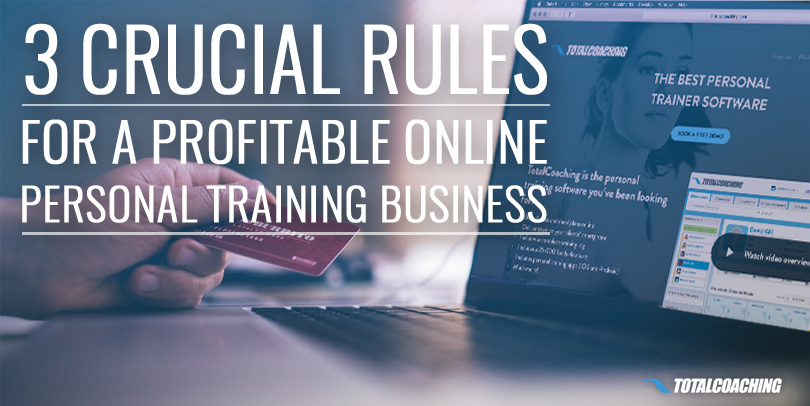When I moved my business from training clients face-to-face to offering online personal training services, I thought my life was going to get so much easier.
I had read The 4-Hour Workweek. I knew all about the high ROI that comes with selling digital goods and services. By not having a physical space to manage or employees to look after, I was going to save time and money. I would outsource the tasks I didn't want to do. Life was going to be easy!
I couldn't have been more wrong.

You know from your own personal training career that the most important service you offer is YOU. Your clients want to feel connected. They want accountability. They need to be motivated.
All of these functions of a personal trainer are true for online training just as they are for face-to-face training. If you're not careful, your online clients can require just as much of your time as face-to-face clients. And that might be okay—your goal is to provide a helpful service to your clients.
You want to give them what they NEED, but that's not always the same thing as what they THINK they need.
It took me far too long to find the perfect balance between giving too much (which doesn't help your clients) and not giving enough (which comes across as being neglectful and lazy).
Now I have a system that gives me the freedom and flexibility I always wanted from online personal training, while also giving my clients exactly what they need. Here are 3 rules you can follow to achieve the same:
Rule #1: Take Control of Your Inbox
Many personal trainers worry that their clients won't want to make the leap from in-person to online training. To help ease that fear, they make support promises like, "Unlimited email support, 7 days per week!"
I made this mistake too. Want to guess what happened next?
You guessed it—I lived in my inbox. My clients were paying me less for online training than they did for in-person sessions, but they were taking up WAY more time because I had set an expectation that any and all questions they ever had about health (and even ones not related to their health) would be answered right away.
This is problematic for two reasons:
- I hated my life (seriously, who likes writing emails all day long?).
- I was training my clients to rely on me, not their own understanding.
Read this statement carefully:
You are not helping your clients if you are creating a dependent relationship. You must teach them independence so that they can grow with your support and on their own.
Imagine you bought a new client booking software for your business. It's full of features that can radically improve your business. But, instead of offering tutorials showing how to use the software, each time you had a question, you were forced to call a 1-800 number to speak to customer service. The service rep would take control of your computer to fix the issue and would then send you on your way.
You might appreciate the help at first, but after a while your mastery of the new software would be so impeded that you'd likely end up feeling pretty frustrated. You want to be in control.
The same is true for your clients.
Break free from the spam and help your clients gain independence
They may THINK they want to be able to email you all day long, but this is just a safety blanket that needs to be removed. Here is the system I use to help my clients develop amazing independence:
1. Check Email Twice per Day
I check once in the morning and once in the afternoon, looking for true emergency emails that I should answer immediately.
2. Set "Office Hours" for Replies
For non-emergency emails, my clients know that they will hear back from me on Thursdays (a.k.a. my "email office hours")
I know what you might be thinking, "Only once per week? That's not enough!" Keep in mind that I do have "touch points" with my clients aside from this (keep reading to learn more), but they are trained to expect a reply to their emails once per week, Thursdays only.
Please drop the "unlimited email support" from your online training services. Teach your clients to be independent thinkers, not reliant on you for every decision (e.g. "Should I eat walnuts or sunflower seeds on my salad?"—seriously, I used to get questions like this!).
Rule #2: Automate, Automate, Automate
Even with Rule #1 in place, you are still going to face a lot of questions that come up over and over again. Do yourself a favour by automating responses so that you can help your clients faster and save oodles of your own time to focus on more important matters. Here's what I do:
1. "Can" Your Responses
If you're not using Gmail, get on that. It offers so many plugins and useful features that there is no excuse to use anything else.
Next, make a list of the top 5-10 questions your online clients ask all the time. For example, "How do I find my new workouts?" or "Where do I record my workout results?"
Then, create a "canned response" for each of those questions. Here's a tutorial that explains how to do this:
I started with a handful of these canned responses and add to my list every time I notice that I'm re-answering the same questions multiple times. As your list grows, your time spent emailing shrinks.
Be sure to personalize the "Hey _____," and perhaps the first line of your email so that it doesn't feel too automated to your clients. They'll appreciate the quick, personalized answer.
2. Use Autoresponse Info Pages
I am a HUGE fan of Clickfunnels for automating much of my business. There are other solutions out there, but after trying many, this is the one I found most helpful.
One of the best features is the automation "Action Funnels" that customers are put into once they join your online training program. I have mine set up to automatically deliver a welcome message, tutorials, and resource pages so that the help my clients need from me diminishes.
For example, when a new client joins my 10 in 4 Challenge, they are redirected to a download page (see below) and are emailed the link to this page several times over the course of the next week:

Does that sound like overkill to you?
Well, experience showed that before automating this process, about 10% of my new clients would ask where these materials were located. That's a lot of my time spent sending emails!
Now, virtually nobody asks about these items because they receive them with regularity during their first week of onboarding into my program.
It's easy to become obsessed with every shiny piece of technology out there that can apparently "help" your business. I love automation, but start with the basics. Automate your email and your program information pages—this will provide a huge return on your time investment.
Rule #3: Chunk Your Support Time
Depending on how much your online clients are paying for your help, you may want to offer phone/Skype support.
Personally, I do offer this service for clients who are buying my higher-end programs (i.e. $299 and up), but I still want to make sure I'm providing the best level of service using the least amount of my time.
Just as I do with my "inbox office hours," I have set "phone/Skype office hours" each week. Using Calendly, my clients can book one such session per week IF they feel it will be beneficial.
Now, some clients will book each week simply because they can. That's fine. You've got to live with it. Others will book only when they have real questions or need legitimate support. Again, your job is to set expectations and do your best to develop independence.
My office hours are open each Tuesday, and time slots are 15 minutes long. Originally, I offered 30-minute slots but found that we spend at least the first 10 minutes or so doing small-talk.
If you want to talk about the weather, go for it, but I'd rather reserve my time for developing programs that will help my clients get results.
Fifteen minute calls are plenty.
During these calls, I ask my clients three things:
- What's going well? (you always want to emphasize the positives!)
- What's been challenging?
- What's going to change next week? (i.e. what's the plan of action?)
It doesn't take long for this conversation to become systematic. Your time is valuable and so is your clients'—an efficient call respects both of your schedules.
How to Set Boundaries With Demanding Clients https://t.co/K8ihy2SrVs @amandaabella pic.twitter.com/BZKooGkCW0
— Due Support (@DueSupport) February 24, 2017
Conclusions
Online personal training has changed my business and my life. In addition, it's allowed me to serve more clients from all over the world. It's a wonderful thing.
But, don't go into it blind. Online personal training has unique challenges that can wind up costing you so much time and money if you're not prepared. Follow these 3 rules to guard your time so that the move towards an online business is the right one for you.




